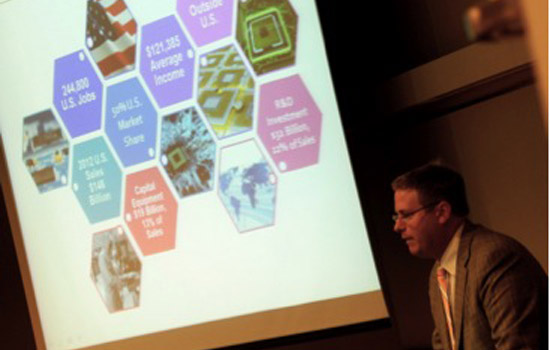Presenters discuss new trends in microelectronics
RIT conference presenters discuss new trends and breakthrough technologies
Michelle Cometa
Ian Steff, vice president, Global Policy and Technology Partnerships of the Semiconductor Industry of America, was the keynote speaker at the 2013 Microelectronic Engineering Annual Conference at RIT.
The semiconductor industry creates jobs and has generated more than $291 billion in worldwide sales of electronic products in the past year, says Ian Steff, vice president, Global Policy and Technology Partnerships of the Semiconductor Industry of America. He was the keynote speaker at the 2013 Microelectronic Engineering Annual Conference at Rochester Institute of Technology on May 7 in RIT’s Kate Gleason College of Engineering.
Steff discussed the growth of the industry driven by consumer and corporate demand for electronic devices for multiple industries. He also focused on the research being done in corporations and universities such as RIT to further develop semiconductor technologies to meet this demand.
“The only way that we will be able to continue to attract manufacturing investment is to focus on workforce, research and investment in companies,” says Steff. “Not only having the companies here, it’s about the workforce and research structure that surrounds it.”
The conference highlighted some of that research. Christopher Hobbs, CMOS Scaling Program manager at SEMATECH, discussed the progress being made in III-V MOSFETs—III-V refers to a group of semiconductor materials, and MOSFET, or metal-oxide-semiconductor and field effect transistor, is one of the devices that incorporates these key materials for building integrated circuits. Silicon continues to be the primary element in chip development, but researchers have incorporated alternative materials such as germanium and indium-gallium-arsenide.
Hobbs also discussed how heat management of the tightly housed transistors is being addressed, and the industry is looking to go beyond current capabilities to high mobility materials, better electrostatic control and tunnel field effect transistors.
RIT and SEMATECH have demonstrated that use of new methods and materials for building integrated circuits, specifically tunneling field effect transistor technology, can reduce power—extending battery life to 10 times longer for mobile applications compared to conventional transistors. RIT doctoral student David Pawlik, one of the conference featured speakers and part of the project team with RIT microelectronic engineering professor Sean Rommel, colleagues at SEMATEACH and Texas State University, described the breakthrough work and the team’s process to build and test vertical Esaki tunnel diodes smaller than 120 nanometers in diameter. This procedure allowed the researchers to measure hundreds of diodes per sample. Because of the nanometer-scale devices tested, the researchers were able to experimentally observe currents substantially larger than any previously reported tunneling currents.
“Things continue to look good for the industry with a quarter of a million jobs in the U.S.; this total grew over the last several years by 5 percent which is higher than the national average,” says Steff. “The semiconductor industry retains a great deal of the market share, and the average income, as you know, is high. Companies reinvest between 17 to 20 percent of revenues for future development. And consumers continue to drive the market.”
The industry is cyclical and sometimes volatile, he says, but has also seen segments such as components for automobiles and sensors, the latter showing growth at an annual rate of nine percent from 2008 to 2012. Tablet technologies also are having an impact on the growth. The Asia-Pacific region is the largest market for semiconductor products with a 56 percent share.
More than 75 attended the microelectronic engineering conference, now in its 31st year.














